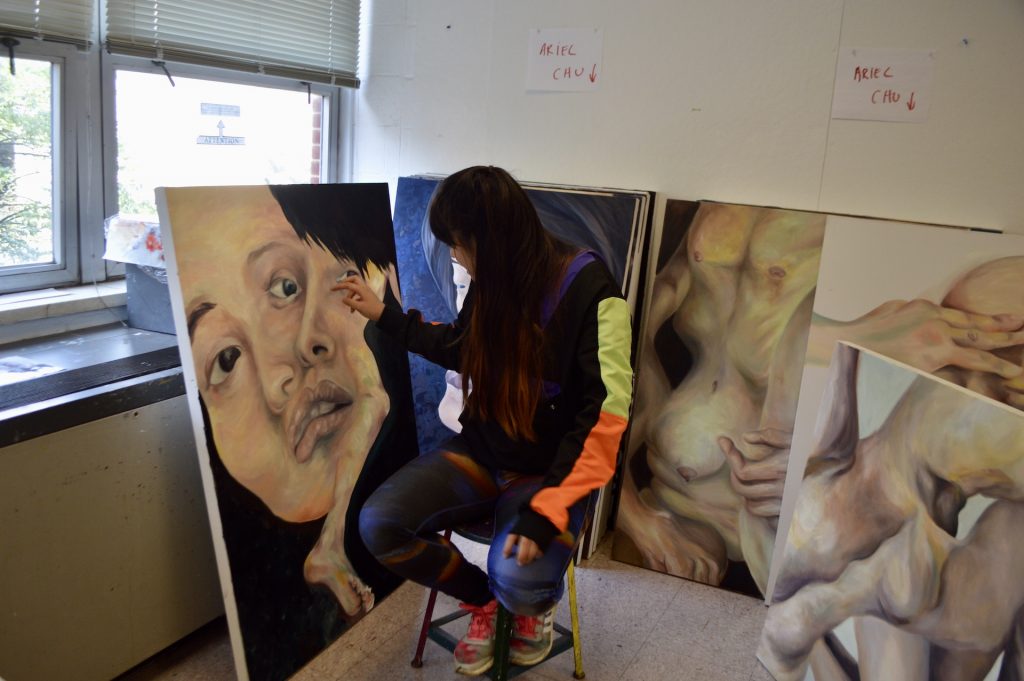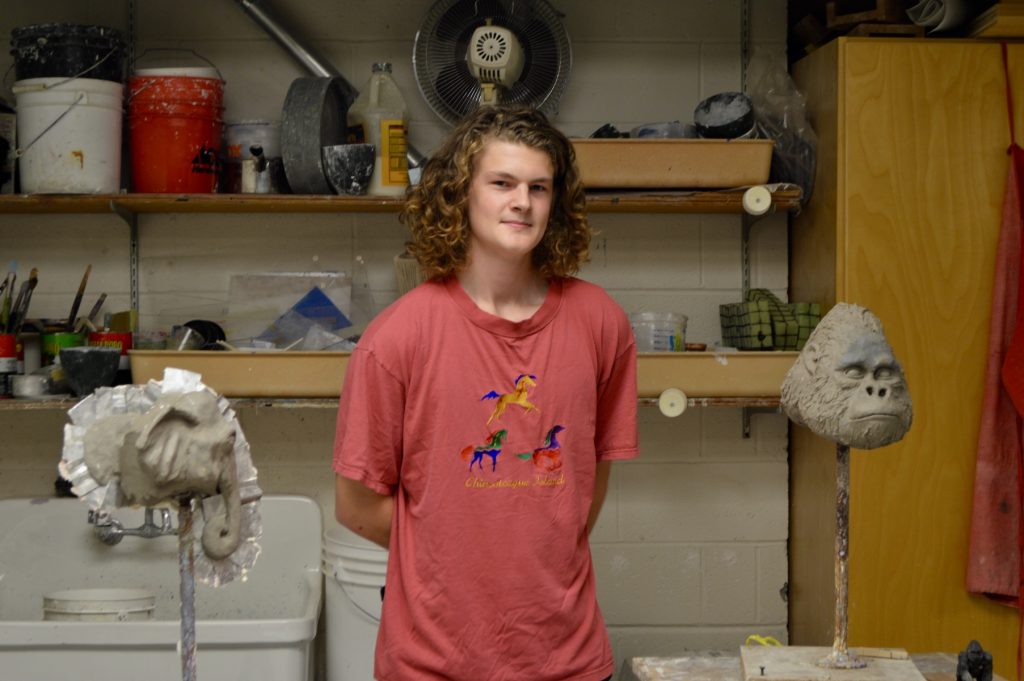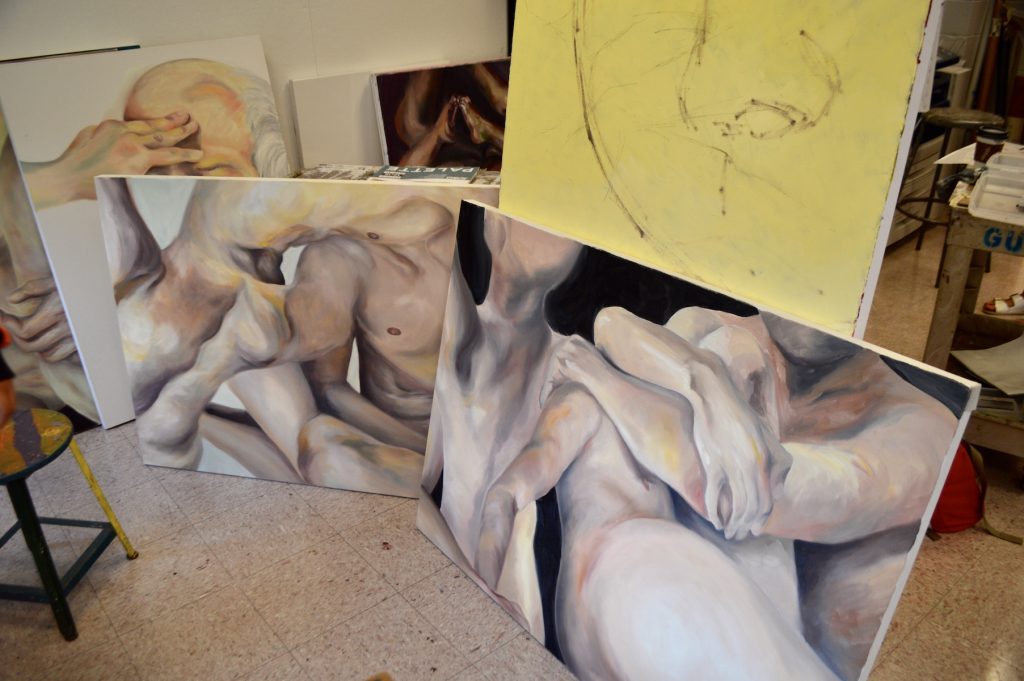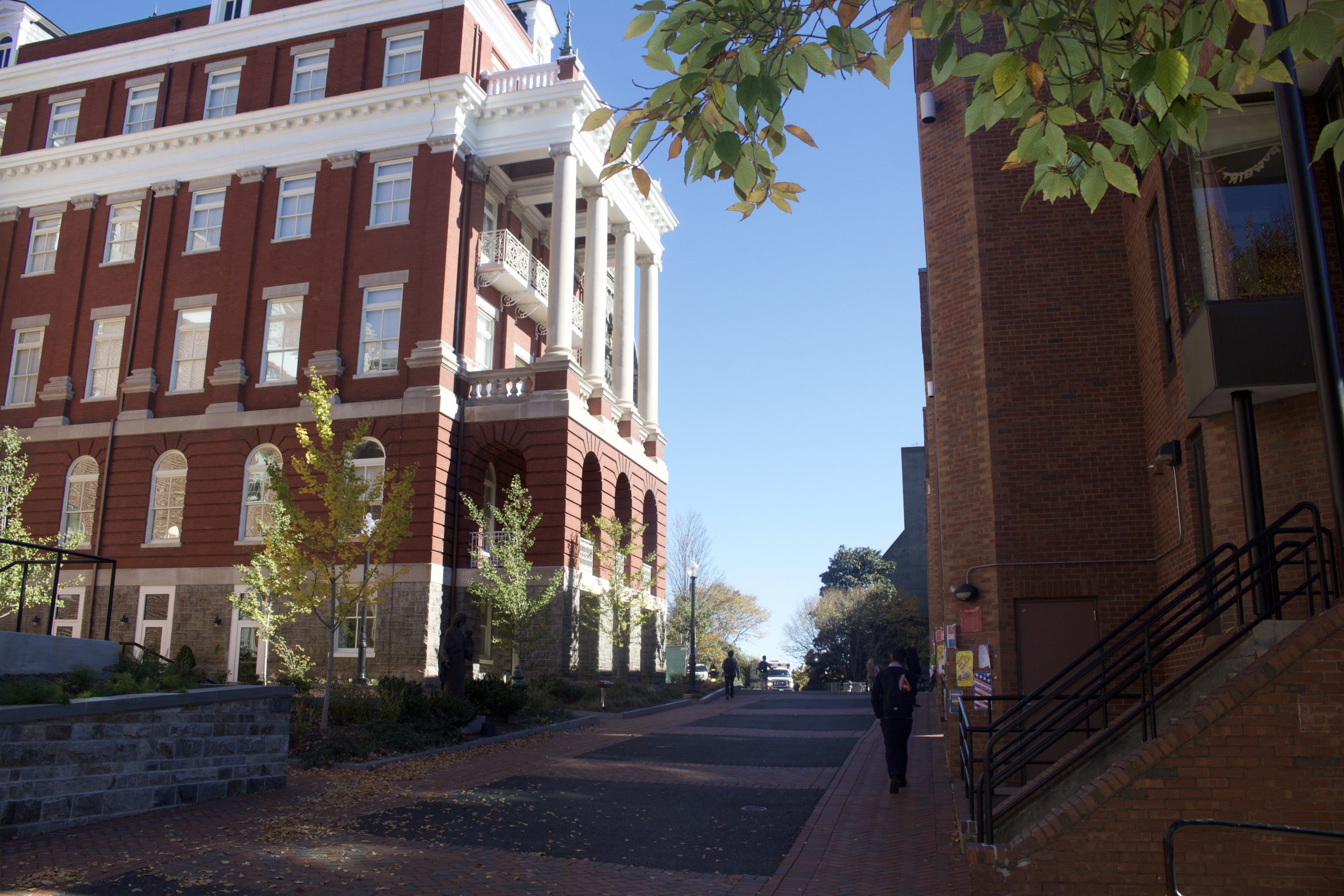When Ariel Chu (COL ’18), one of the 12 studio art majors in this year’s graduating class, was deciding where to go to college, she had narrowed it down to two schools: Maryland Institute College of Art (MICA), the 17th best college for art in America according to Niche, or Georgetown University, an elite, international university.
“I visited MICA, and when I talked to the illustration department head he actually suggested I go to Georgetown, and if I didn’t like it I could always come back. Four years later, here I am,” said Chu.
Georgetown is primarily known for its excellence in government, business, and foreign service. As a result, other subjects often get overlooked. Despite the art program’s relatively small size and popularity, Georgetown’s overall reputation gives confidence to students such as Chu. “I knew it was a top-notch school with a great reputation, so I just expected it to have a good art program, however small,” she said.
Chu’s expectations were legitimate, considering the existing relationship between art education and academic prestige. Appreciation and exploration of the arts have always been core components of intellectualism and pillars of liberal arts education. Many universities with comparable ranking to Georgetown have actively invested in the artistic development of their student body for many years, evidenced by the size and prominence of their art programs. But Georgetown, while sharing the belief in a holistic model of education, does not measure up when it comes to investing in and cultivating involvement in the arts.
“If you look at other art departments in schools that are around Georgetown’s level in terms of stature and ranking, they’re bigger, they have more money in them, and they have more students taking their classes,” said Mark Keffer (COL ’19), another studio art major.
Al Acres, professor of art history and chair of the art and art history department, explained the department’s relatively belated origins.
“In 1967, the Department of Art, Music, and Theater was founded, and only about 10 years ago, art and art history became their own department. That makes us a young art department compared to those in other major research universities, who had them long before that,” he said.


Katheryn Dunn sits with her latest project.
Because of its recent conception, Georgetown’s Department of Art and Art History is small compared to others on campus. It offers a major and minor in studio art and art history for undergraduates and consists of nine full-time faculty members, six of whom are tenured, and 13 part-time professors. In comparison, schools of Georgetown’s caliber, such as Washington University in St. Louis (WashU), University of Pennsylvania, and Yale University have upwards of 45 faculty members in their art programs. Some schools, such as WashU also offer other art-related majors like communication design and fashion design.
Another important component of artistic presence on university campuses is the availability of university-owned art, displayed in galleries and college museums. Yale’s all encompassing art gallery may be the most famous example, featuring works by Peter Paul Rubens, Vincent Van Gogh, Pablo Picasso, and many other renowned artists, but it is not alone. Of the US News and World Report’s top 20 national universities, 15 have art museums with permanent collections. Georgetown is one of the five that does not.
Although it does not have a permanent art museum, Georgetown has displayed seasonal exhibitions and pieces by senior art majors in the Spagnuolo Gallery over the last 15 years. However, as a result of its small size and inconspicuous location on the first floor of the Edmund A. Walsh building, it hasn’t received much attention. In fact, many students don’t even know it exists.
“Faculty over the years hear the student tours going around. And these families who’ve been touring other universities would ask ‘where is the art gallery?’ and the students always said ‘there isn’t one,’” Acres said. This is, said Acres, in spite of the Spagnuolo gallery’s small but significant presence on campus.
Professor Acres, who has previously worked at University of Oregon and Princeton, offered some insight as to what led to a strong art presence and education department in peer institutions.
“Very wealthy, old universities, with prominent alumni donors were collecting art by the nineteenth century, and collecting with an eye towards teaching,” he said.
Despite being founded over 200 years ago, Georgetown does not share this long history of wealth and alumni donations, a factor that has given it “a different kind of profile over the years,” according to Acres. For the first century of its existence, Georgetown was a small, religious college, not the internationally-recognized university it is today. According to the university website, only in the 1970s, under the leadership of university presidents Rev. Timothy Healy and then Rev. Leo O’Donovan, did Georgetown “grow from a regional school to one of national prominence.”


Ariel Chu describes a painting.
This growth refers in part to the Third Century Campaign, a project started by university President Rev. Leo O’Donovan in 1995 in an effort to increase Georgetown’s small endowment. The campaign was successful in attracting donors, raising $1 billion over the course of 8 years. Nevertheless, at $1.5 billion, Georgetown’s current endowment is still one of the lowest, compared to Notre Dame’s $8.6 billion, UPenn’s $10.1 billion, and Stanford’s $22.2 billion.
A historically small endowment, combined with the prioritization of other projects and liberal arts subject areas, has resulted in a lack of funding for art programs and facilities at Georgetown and an inability to accrue a substantial university art collection, especially as famous art collections have developed nearby.
Albey Miner, the new gallery director, identified Georgetown’s advantageous location as another factor that has contributed to its modest art presence.
“Other university collections had a purpose to teach and create a campus culture that might not have been there geographically. Many prestigious colleges are in quasi-rural areas or small cities, so it was also an amenity to the community to build museums there,” he said.
Georgetown, on the other hand, is located within walking distance of some of the world’s most renowned art museums. Existing in such an artistically rich, diverse, and vibrant community has relieved the university from personally ful lling its students’ artistic needs.
However, the lively art scene is hardly what attracts students to Georgetown’s location in the nation’s capital. Government, foreign service, and business consistently draw in freshmen set on becoming senators, ambassadors, and Wall Street CEOs. In this career-oriented, competitive atmosphere, many creative disciplines, not just art, are often forgotten, despite Georgetown’s claim to “cura personalis”—education of the whole person.
“A lot of people I’ve met here are very focused on what they’ll be doing in future, so they’re taking classes that will lead them to that future, not classes they’re currently interested in,” said Daniel Eigler-Harding (COL ’20), a sophomore on the pre-med track currently doing an independent study in sculpture.


Daniel Eigler-Harding displays his work.
Even with a pre-professionalism trend, Georgetown has the ability to foster interest in less pragmatic liberal arts fields, and the core requirements in philosophy and theology are proof of this power.
“The Problem of God” is a signature part of the Georgetown experience, requiring students to take a break from their professional ambitions to examine their faith and explore the philosophical bases of various religions, a first for many. While opinions of the class differ, the registrar’s class description boasts that “graduates consistently report that The Problem of God was one of the most important courses that they took during their time at Georgetown.”
The effort to promote interest in philosophy and theology aligns with the priorities of the Society of Jesus, which doesn’t concern itself nearly as much with visual art. Undergraduates are required to take two classes in both theology and philosophy, but only one in the humanities or arts. As a result, many students do not take an art class while on campus.
“What’s really enjoyable about art is that you get to create something with your own hands and see your progress, and I think that’s a really rewarding feeling that is unique to art,” Eigler-Harding said.
As a member of the committee that decides the class requirements for students, Al Acres is well aware that the core curriculum betrays the student body’s ignorance in art. “Right now, art isn’t central to people’s vision of what Georgetown is because it was never a part of the mission or the identity of the university,” Acres said. “But that’s beginning to change,” he added.
Since the founding of the Art, Music, and Theater department in 1967, faculty and student supporters of the arts have begun to yield more results than ever.
The emergence of a large, organized student art community and the construction of a new, bigger, and more accessible art gallery both point to a hopeful future for art at Georgetown.
In July of 2016, Alexander Lubeck(MSB ’17) created the Georgetown University Collective of Creative Individuals for people to share their art, celebrating creativity at Georgetown, and inspiring artistic collaboration.
“I knew that every year there would be kids like me, who come in to Georgetown expecting and wanting an organized, accepting artistic community that’s not infected with Georgetown’s pre-professional culture, and I wanted to make that space for them,” Lubeck said.


Paintings by Ariel Chu.
Lubeck graduated this past spring, but GUCCI has continued to expand. What started as a Facebook group of about 100 people has quickly grown to 688 members, with new students, both artists and art lovers, joining almost every day.
Group members organize various art-related events, such as art shares, music shows, and open mics, which all happened at Georgetown before GUCCI, Lubeck noted, but not on the scale and level of accessibility that they do now.
“A big thing was making a group that’s inclusive and welcoming, unlike a lot of Georgetown clubs. At first, people would go on the Facebook page and be like ‘Wow, anyone can join?’” he said.
As Georgetown students have begun to organize to create and admire art, a university-supported project to build a new art gallery while renovating the existing one is also underway.
The new de la Cruz Gallery will open on Nov. 8 with an event co-sponsored by the art department and the Georgetown University Law Center.
“A law professor will be leading a conversation with world-renowned, extraordinary artist Wangechi Mutu in the second installment of a series of talks titled ‘Dialogues on Being Human’ about art and human rights,” Miner explained.
The art department hopes to regularly host interdisciplinary events in order to attract a wide audience of faculty, students, and other members of the Georgetown community.
“The gallery will be a space where you’ll see performance some capacities,” Miner said. “We’re hoping to have more interactive and theatrical components that will make the programs socially and politically relevant but also dynamic and immersive. Down the road we want to have events that engage the departments of philosophy, theology, government. A truly interdisciplinary approach.”
Both the gallery director and the department chair expressed confidence in the positive effects that the new galleries will have on student involvement in art at Georgetown. “The kind of energy and visibility that’s going to come with the galleries will create more magnetism to the curriculum in the arts,” Acres said.
But before attracting new students to the arts, Georgetown must improve the academic experience for current people like Chu, Keffer, and other studio art majors. Limited facilities and lack of funding stand in the way of Georgetown catching up to its peers in art education.
“I think it’s great that there is new gallery with the opportunity to bring in famous artists and attract large audiences,” Chu said. “But, at the end of the day, the university needs to care more about the opportunities and resources available to its own art students.”
For the rest of Georgetown’s students, fundamental changes in their habits, mindsets, and values will not happen overnight. Pre-professionalism, “consulting culture,” and the hierarchy of majors are strands still woven tightly into the fabric of the university culture, preventing many Hoyas from taking time to explore the arts.
However, Lubeck pointed out that art has always been a revolutionary force, and there is potential for it to be one at Georgetown.
“All we can do is hope that people will continue sharing their art and inspiring each other,” he said. “Maybe one day it will have a larger effect on students overall, and people who didn’t care about art before college will actually be encouraged to explore it here.”
Photo Credit: Isabel Lord





